Upregulation of MELK promotes chemoresistance and induces macrophage M2 polarization via CSF-1/JAK2/STAT3 pathway in gastric cancer
- PMID: 39135038
- PMCID: PMC11320770
- DOI: 10.1186/s12935-024-03453-8
Upregulation of MELK promotes chemoresistance and induces macrophage M2 polarization via CSF-1/JAK2/STAT3 pathway in gastric cancer
Abstract
Background: Gastric cancer (GC) stands out as one of the most prevalent malignancies affecting the digestive system, characterized by a substantial incidence rate and mortality. Maternal embryonic leucine zipper kinase (MELK) has been implicated in the advancement of various cancer types and the modulation of the tumor microenvironment. This study aims to delve into the involvement of MELK in chemoresistance and the tumor microenvironment of GC.
Methods: The MELK expression was detected using quantitative real-time polymerase chain reaction (qRT-PCR), western blotting and immunohistochemistry. Lentiviral transfection was employed to establish stable cell lines with either overexpressed or silenced MELK. The impact of MELK on the chemoresistance of GC cells and the polarization of macrophages was investigated through in vitro and in vivo functional assays. Additionally, the correlation between MELK and the cytokines colony-stimulating factor 1 (CSF-1), as well as stromal macrophages, was analysed. The prognostic significance of MELK, CSF-1, and CD206 expression levels in clinical samples was further investigated.
Results: MELK was found to be highly expressed in chemoresistant GC cells and tissues. Furthermore, both in vitro and in vivo assays indicated that MELK overexpression conferred chemoresistance in GC cells. Additionally, MELK overexpression was observed to induce M2 macrophage polarization via the CSF-1/JAK2/STAT3 pathway, thereby contributing to chemoresistance within the tumor microenvironment. The expression of MELK in GC tissues from neoadjuvant chemotherapy patients correlated positively with CSF-1 and CD206. Moreover, patients with higher expression levels of MELK, CSF-1, or CD206 exhibited significantly shorter OS and DFS rates.
Conclusions: Our investigation underscores the critical role of MELK in promoting chemoresistance and inducing M2 macrophage polarization in GC. It proposes novel targets and methods for the treatment of GC, as well as prognostic factors for neoadjuvant chemotherapy.
Keywords: Chemoresistance; Gastric cancer; MELK; Polarization; Prognosis; Tumor-associated macrophages.
© 2024. The Author(s).
Conflict of interest statement
The authors declare no competing interests.
Figures
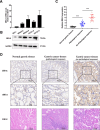
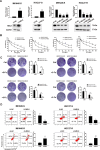

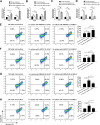

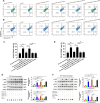
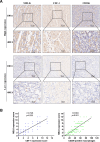

Similar articles
-
Upregulated MELK Leads to Doxorubicin Chemoresistance and M2 Macrophage Polarization via the miR-34a/JAK2/STAT3 Pathway in Uterine Leiomyosarcoma.Front Oncol. 2020 Apr 22;10:453. doi: 10.3389/fonc.2020.00453. eCollection 2020. Front Oncol. 2020. PMID: 32391256 Free PMC article.
-
[Gastric cancer-derived mesenchymal stem cells regulate the M2 polarization of macrophages within gastric cancer microenvironment via JAK2/STAT3 signaling pathway].Zhonghua Zhong Liu Za Zhi. 2022 Jul 23;44(7):728-736. doi: 10.3760/cma.j.cn112152-20200106-00008. Zhonghua Zhong Liu Za Zhi. 2022. PMID: 35880339 Chinese.
-
Crosstalk between tumor-associated macrophages and tumor cells promotes chemoresistance via CXCL5/PI3K/AKT/mTOR pathway in gastric cancer.Cancer Cell Int. 2022 Sep 23;22(1):290. doi: 10.1186/s12935-022-02717-5. Cancer Cell Int. 2022. PMID: 36151545 Free PMC article.
-
Maternal embryonic leucine zipper kinase in tumor cells and tumor microenvironment: An emerging player and promising therapeutic opportunity.Cancer Lett. 2023 Apr 28;560:216126. doi: 10.1016/j.canlet.2023.216126. Epub 2023 Mar 16. Cancer Lett. 2023. PMID: 36933780 Review.
-
Role of Interleukins and New Perspectives in Mechanisms of Resistance to Chemotherapy in Gastric Cancer.Biomedicines. 2022 Jul 5;10(7):1600. doi: 10.3390/biomedicines10071600. Biomedicines. 2022. PMID: 35884907 Free PMC article. Review.
Cited by
-
Stachydrine targeting tumor-associated macrophages inhibit colorectal cancer liver metastasis by regulating the JAK2/STAT3 pathway.Front Pharmacol. 2025 Feb 5;16:1514158. doi: 10.3389/fphar.2025.1514158. eCollection 2025. Front Pharmacol. 2025. PMID: 39974738 Free PMC article.
-
Reversal of chemotherapy resistance in gastric cancer with traditional Chinese medicine as sensitizer: potential mechanism of action.Front Oncol. 2025 Feb 20;15:1524182. doi: 10.3389/fonc.2025.1524182. eCollection 2025. Front Oncol. 2025. PMID: 40052129 Free PMC article. Review.
-
Nuclear receptor subfamily 1 group D member 2 induces chemoresistance in ovarian cancer by regulating ferroptosis and immune infiltration.Discov Oncol. 2025 Jul 1;16(1):1215. doi: 10.1007/s12672-025-03051-8. Discov Oncol. 2025. PMID: 40591055 Free PMC article.
-
Gastric cancer-derived exosomal let-7 g-5p mediated by SERPINE1 promotes macrophage M2 polarization and gastric cancer progression.J Exp Clin Cancer Res. 2025 Jan 2;44(1):2. doi: 10.1186/s13046-024-03269-4. J Exp Clin Cancer Res. 2025. PMID: 39748408 Free PMC article.
-
Ginsenoside Rh7 affects β-catenin nuclear translocation by inhibiting SHCBP1 expression, thereby inhibiting epithelial-mesenchymal transition in gastric cancer cells.Int J Med Sci. 2025 Jun 23;22(12):3053-3069. doi: 10.7150/ijms.112622. eCollection 2025. Int J Med Sci. 2025. PMID: 40657397 Free PMC article.
References
Grants and funding
LinkOut - more resources
Full Text Sources
Research Materials
Miscellaneous

